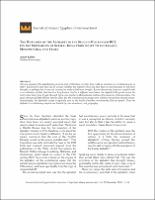Please use this identifier to cite or link to this item:
https://hdl.handle.net/20.500.12202/4435Full metadata record
| DC Field | Value | Language |
|---|---|---|
| dc.contributor.author | Koller, Aaron | - |
| dc.date.accessioned | 2019-06-27T14:13:05Z | - |
| dc.date.available | 2019-06-27T14:13:05Z | - |
| dc.date.issued | 2018-12 | - |
| dc.identifier.citation | Koller, Aaron. (2018). The Diffusion of the Alphabet in the Second Millennium BCE: On the Movements of Scribal Ideas from Egypt to the Levant, Mesopotamia, and Yemen. Journal of Ancient Egyptian Interconnections (20), 1-14. | en_US |
| dc.identifier.issn | 1944-2815 | - |
| dc.identifier.uri | https://journals.uair.arizona.edu/index.php/jaei/article/view/23126 | en_US |
| dc.identifier.uri | https://hdl.handle.net/20.500.12202/4435 | - |
| dc.description | Scholarly research article | en_US |
| dc.description.abstract | The non-impact of the alphabet has garnered a lot of attention recently: how could an invention so revolutionary do so little? Researchers have been led to wonder whether the alphabet may not have been as revolutionary as had been thought, or perhaps that it was not invented as early as had been thought. Recent discoveries, however, coupled with a re-evaluation of data that has been long known, lead to a different conclusion: the alphabet did spread across the entire Near East, from Egypt, through Syria, into southern Mesopotamia, within a few centuries of its invention. The exact chronology differed from place to place, but the transmission is always seen to follow the opening of trade routes. Interestingly, the alphabetic script is typically seen in the hands of scribes, not formerly illiterate people. Thus the alphabet’s revolutionary impact was limited by class structures, not geography. | en_US |
| dc.description.sponsorship | ACKNOWLEDGMENTS This paper originated in a contribution at the Annual Conference of the American Schools of Oriental Research in 2017, in a session on “The History of the Early Alphabet.” I am grateful to Thomas Schneider and Orly Goldwasser for organizing the session, and to the other participant—Schneider, Ben Haring, Christopher Rollston, and Alice Mandell—for a stimulating session and helpful comments and questions. I am also grateful to William Schniedewind for some insightful remarks on the topic | en_US |
| dc.language.iso | en_US | en_US |
| dc.publisher | University of Arizona | en_US |
| dc.relation.ispartofseries | Journal of Ancient Egyptian Interconnections;20 | - |
| dc.rights | Attribution-NonCommercial-NoDerivs 3.0 United States | * |
| dc.rights.uri | http://creativecommons.org/licenses/by-nc-nd/3.0/us/ | * |
| dc.subject | alphabet | en_US |
| dc.subject | Egypt | en_US |
| dc.subject | Levant | en_US |
| dc.subject | Mesopotamia | en_US |
| dc.subject | Yemen | en_US |
| dc.subject | invention of the alphabet | en_US |
| dc.subject | language innovation | en_US |
| dc.subject | ancient inscriptions | en_US |
| dc.subject | history of writing | en_US |
| dc.subject | Ugaritic | en_US |
| dc.subject | abecedary | en_US |
| dc.subject | Abecedarium | en_US |
| dc.subject | Akkadian cuneiform | en_US |
| dc.subject | paleography | en_US |
| dc.subject | Aramaic dockets | en_US |
| dc.title | The Diffusion of the Alphabet in the Second Millennium BCE: On the Movements of Scribal Ideas from Egypt to the Levant, Mesopotamia, and Yemen. | en_US |
| dc.type | Article | en_US |
| local.yu.facultypage | https://www.yu.edu/faculty/pages/koller-aaron | |
| Appears in Collections: | Yeshiva College: Faculty Publications | |
Files in This Item:
| File | Description | Size | Format | |
|---|---|---|---|---|
| Koller Alphabet in the Second Millennium JAEI 2018.pdf | PDF author | 278.35 kB | Adobe PDF |  View/Open |
This item is licensed under a Creative Commons License

